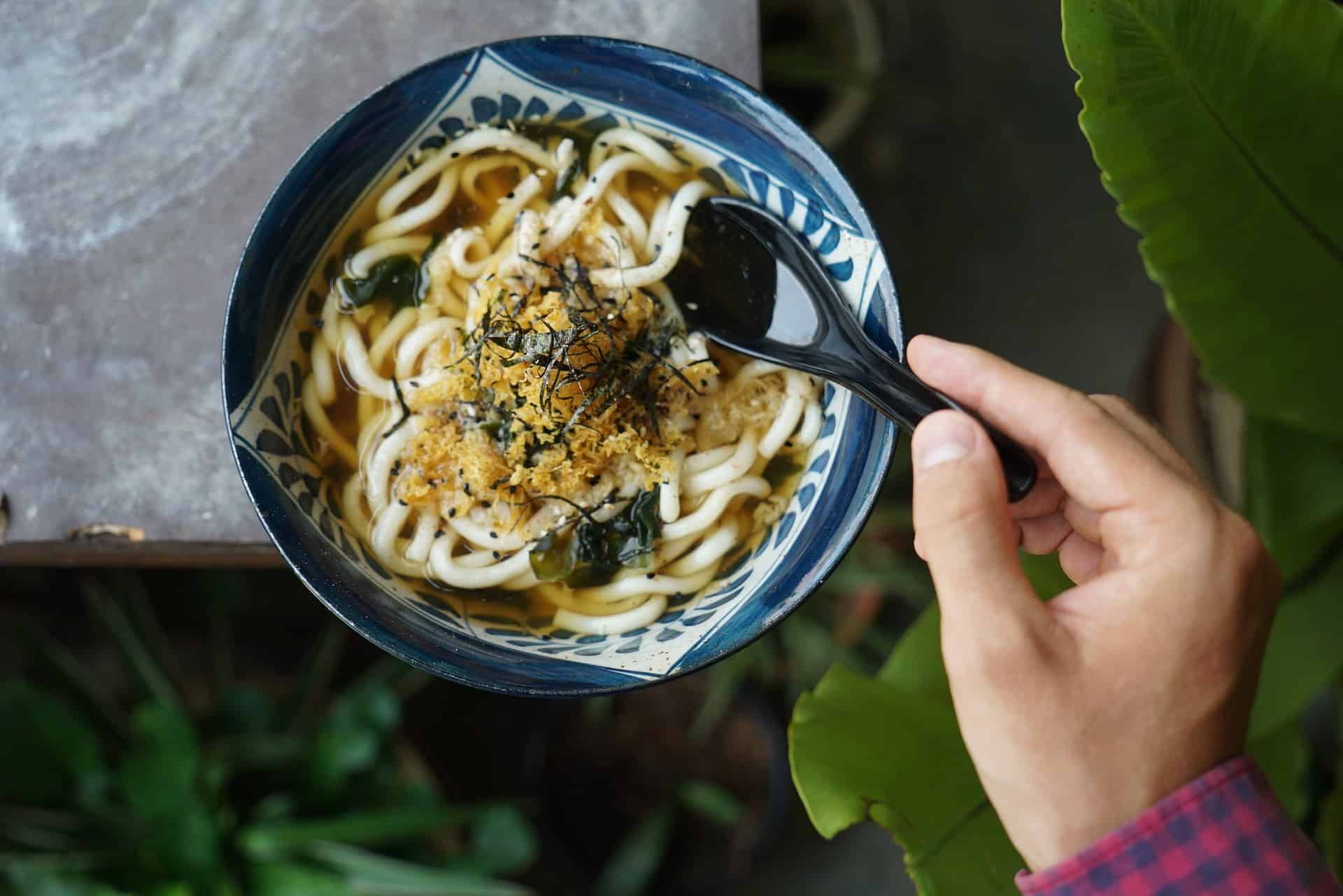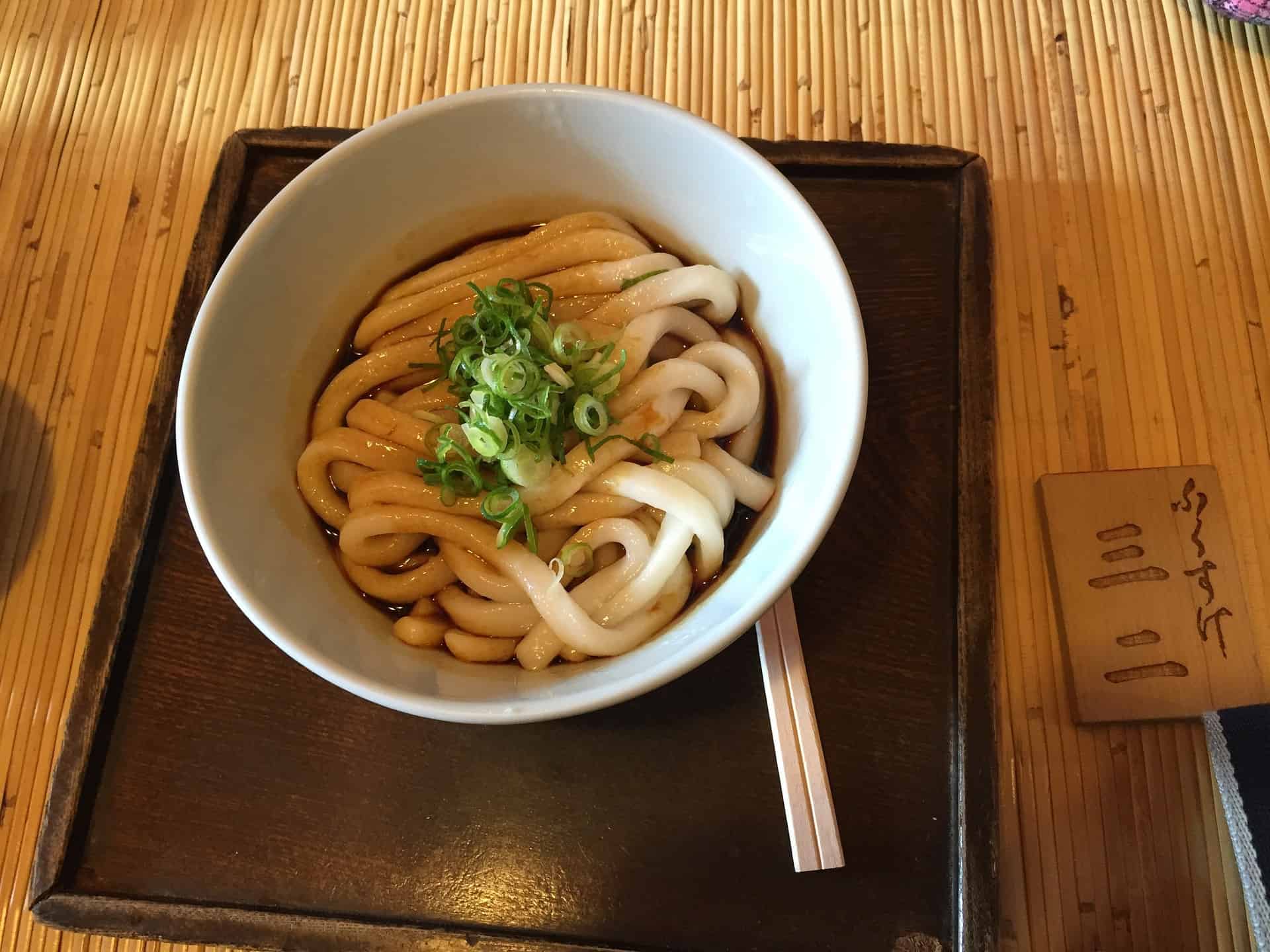What are the thick Japanese noodles called? Is there more than 1 type?
Thanks to its umami tastes and the use of a large range of fresh ingredients, Japanese cuisine is widely celebrated. While sashimi and sushi are possibly the 2 most prominent dishes, many have also come to love and appreciate Japanese noodles.
Notice that I’m not referring to the highly processed instant noodles that only provide empty calories and additives — these can damage your health.
I’m actually talking about authentic Japanese noodles, such as soba, ramen, and most importantly, thick Japanese noodles: udon noodles.

Udon, in general, is being pushed aside in favor of its more successful relatives, but there’s a lot about this Japanese food you should learn about. Continue reading for more information on udon noodles.
Udon (うどん), pronounced [oo-don], is thick Japanese wheat flour noodles. They’re white in color, and also thicker and chewier than soba noodles.
Udon is widely available and served in various hot and cold dishes at restaurants in Japan.
Here’s a brief introduction to udon noodles from Pro Home Cooks on YouTube:

Check out our new cookbook
Bitemybun's family recipes with complete meal planner and recipe guide.
Try it out for free with Kindle Unlimited:
Read for freeIn this post we'll cover:
Are udon noodles healthy?
If you struggle with insulin resistance, you may not be able to consume udon noodles since they’re not the healthiest meal out there. Udon noodles are made of wheat, making them a food with a high amount of carbohydrates.
Generally speaking, I’d advise you to keep your net carbohydrates below 15 or 20 grams a day, particularly if your body hasn’t recovered the ability to burn fat as fuel.
Udon nutritional facts
Udon noodles can contain up to 65 grams of carbohydrates per serving (or more depending on the manufacturer), which goes beyond my recommendations. Consuming this in large quantities could greatly impair your ability to burn fat.
Therefore, you have to avoid grains (including wheat) in the early days of recovering this capacity. Nonetheless, once you have reached dietary ketosis, you can safely add wheat back into your diet, but in small amounts.
Udon noodles aren’t impressive in terms of nutrition. The USDA Food Database states that a 100-gram udon serving can provide you with 2.6 grams of dietary fiber, 3.55 milligrams of iron, and 26 grams of calcium, but not much else.
So if you want to enjoy a truly nutritious meal with udon noodles, you need to prepare them with a range of good, whole-food ingredients.
Also read: Japanese ramen is delicious and you can get it in these 5 varieties
Where you can eat udon noodles?
Udon can be found in specialty udon and soba restaurants in Japan, casual dining restaurants (such as family restaurants), izakaya restaurants, and restaurants around tourist sites. There are also several popular restaurant chains with low-cost udon outlets in the big cities and along national routes.
A standard udon dish typically costs between 500 yen and 1,000 yen at an average restaurant, but low-cost udon chains frequently offer meals for less than 500 yen. Expect to pay from 1,000 yen to 1,500 yen per person at more upmarket eateries or for more elaborate udon dishes.
Standing udon restaurants can be found at some busy train stations for a quick meal between train rides. It’s as simple as buying your meal ticket from the vending machine in standing restaurants, handing it to the workers, and eating your noodles while standing at the counter.
Some udon low-cost chains operate like a cafeteria line. After entering the restaurant, customers pick up a tray, order the dish from the workers behind the counter, and then choose possible side dishes like tempura, rice balls, or oden (simmered vegetables) before heading to the cashier at the end of the counter.
How to eat udon noodles
The way you eat udon depends on how it’s served. Take a few strands of noodles and dip them in the sauce before consuming them when udon is served with a sauce.
Udon eaten in a soup or sauce is enjoyed by using your chopsticks to put the noodles into your mouth and making a slurping noise. The slurping strengthens the flavors when they enter your mouth and helps to cool down the hot noodles.
When there’s a broth, you drink it straight from the cup, removing the need for a fork. Leaving any leftover soup in the bowl at the end of the meal isn’t considered rude.
Popular udon noodles dishes
Below is a list of udon dishes commonly found by tourists in Japanese restaurants. Remember that in terms of naming and seasoning, there are some regional differences.

Kake udon (hot)
Kake udon is a typical udon dish that’s served in a hot broth covering the noodles. It has no toppings and typically, only green onions are put on top as a garnish. In the Osaka area, kake udon is also known as su udon.
Kamaage udon (hot)
Kamaage udon noodles are served in hot water and paired with a number of seasonings and a dipping sauce. Many locations offer kamaage udon’s individual servings in small wooden bowls, while others serve kamaage udon’s family-sized portions in large shared wooden tubs.
Tsukimi udon (hot)
Like its soba equivalent, tsukimi udon (“moon viewing udon”) features a raw egg on top of the udon noodles to imitate the moon.
Curry udon (hot)
Curry udon is udon noodles that are served in a Japanese curry pot. It’s a common winter dish to eat, as it’s very warm. Many restaurants offer disposable bibs because eating curry udon can be messy.
Please be careful when eating curry udon when they aren’t offered, as the udon noodles are prone to splashing curry on nearby clothing.
Chikara udon (hot)
Chikara udon is udon noodles that are eaten in the hot broth by adding a rice cake (mochi). The Japanese word “chikara” (meaning power) is used, as it’s believed that adding mochi to the dish gives the person eating it energy.
Nabeyaki udon (hot)
Nabeyaki udon is a cooked dish served in a hot pot (nabe). The udon noodles are prepared with the broth and vegetables directly in the nabe.
Upon serving, tempura is a common addition. But the most popular ingredients are mushrooms, eggs, kamaboko (a pink and white steamed fish cake), and various vegetables.
Most shops will only sell this dish during the year’s colder months.
Zaru udon (cold)
Zaru udon noodles are served cooled on a bamboo mat. They’re paired with a dipping sauce and before eating, they’re soaked in the dipping sauce. It’s very similar to zaru soba; the only difference is the noodle style.
Tanuki udon (hot/cold)
Tanuki udon is served in a deep-fried tempura batter (tenkasu) with leftover broth. Tanuki udon isn’t normally served in Osaka, as tenkasu is often available at restaurants there free of charge.
Kitsune udon (hot/cold)
Kitsune udon is udon noodles served in a hot broth with aburaage on top, which is thin sheets of fried tofu.
Tempura udon (hot/cold)
Typically, tempura udon is eaten in a hot broth with bits of tempura on top of the noodles. Sometimes, the tempura is placed next to the bowl or tray of noodles on a separate platform. Tempura ingredients differ from season to season and depend on the stores that sell them.
Regional varieties
As we mentioned before, sometimes, udon might change according to the region since it’s popular all across Japan. Next, you’ll find a list of the most common varieties.
Sanuki udon
Named after Kagawa prefecture’s former province, sanuki udon is Japan’s most popular udon variety. The noodles are strong and chewy, and have a variety of forms to be eaten. Udon in Kagawa prefecture is a very popular and cheap meal. Sanuki udon is served by many of the famous, nationwide udon chains.
Mizusawa udon
Traditionally handmade from local wheat flour and spring water from Mount Mizusawa, mizusawa udon has a long history of feeding pilgrims on their way to Mizusawa Temple near Ikaho Onsen. Usually, mizusawa udon is served chilled with either a dipping sauce based on soy or a dipping sauce with sesame, sometimes both.
Ise udon
The rich and dark sauce (tsuyu) poured on top of the udon noodles is a characteristic of ise udon. This rich and dark tsuyu consists of dried kelp or smoked fish (normally bonito or small sardines) and soy sauce. Usually on top of the udon noodles are green onions and katsuobushi (smoked bonito flakes). Ise udon is served by many restaurants around the Ise Shrines.
Kishimen
Specific to Nagoya, kishimen is a flat and thin version of udon noodles similar to the fettuccine form. The ingredients used to produce kishimen are no different from udon noodles. The main difference is the form and time taken to cook the noodles.
Also read: this is the Japanese sushi eel everyone’s talking about
Inaniwa udon
With more than 300 years of history, it takes about 4 days to make inaniwa udon as it’s all done manually! It’s wrapped between 2 rods after kneading the dough by hand, flattened, then stretched, and eventually, air-dried. The handmade method results in inaniwa udon noodles that have a smooth texture and are thinner than traditional udon noodles.
Hoto
Compared to regular udon noodles, hoto noodles are flatter and wider. In a miso-based soup, they’re usually cooked in a cast-iron hot pot with lots of vegetables. Quite seasonal vegetables, including pumpkin, are the vegetables that go into hoto.
Misonikomi
The specialty for Nagoya is misonikomi udon. It’s a very rich winter dish and especially popular.
For its soup base, it uses red miso. Chicken, green onions, mushrooms, a raw egg on top, and rice cakes (mochi) are other popular ingredients.
Okinawa soba
While it’s called soba, Okinawa soba isn’t made with buckwheat flour, but instead, wheat flour. Its consistency is more of a cross between the noodles of ramen and udon. Typically, Okinawa soba is served in a cold pork broth with cooked pork slices, green onions, and pickled ginger.
And before we end this article, we want to share a simple recipe so you can give it a try at home.
Simple udon soup
Ingredients
● 2 packs of pre-cooked or frozen udon noodles
● 1 egg
● Negi or Welsh onion (to taste)
Seasoning/Other
● 4 cups of dashi broth
● 1 tbsp of mirin
● 2 tbsp of soy sauce
Preparation
- Put the dashi broth into a large pot and bring to a boil. Add the mirin and soy sauce.
- Add the udon and boil 1 minute less than the package instructions say(usually 2-3 minutes for pre-cooked or frozen udon).
- Crack the egg in, add the negi, and cook for 1 additional minute. Serve hot!
And that’s it! We hope you enjoy this delicious udon noodle soup recipe at home.
Check out our new cookbook
Bitemybun's family recipes with complete meal planner and recipe guide.
Try it out for free with Kindle Unlimited:
Read for freeJoost Nusselder, the founder of Bite My Bun is a content marketer, dad and loves trying out new food with Japanese food at the heart of his passion, and together with his team he's been creating in-depth blog articles since 2016 to help loyal readers with recipes and cooking tips.
